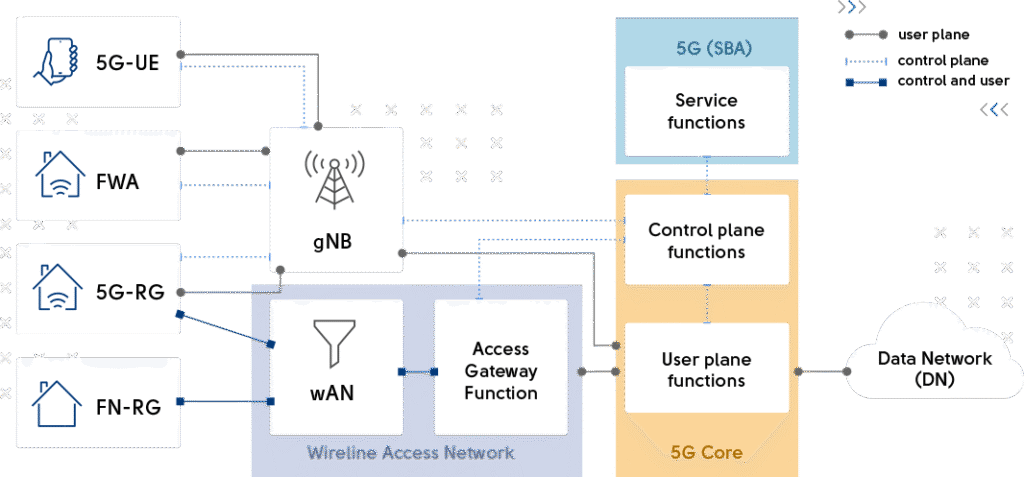Challenge
Our client is a cloud-native pioneer in the telecom and network software industry, leading the market with mobile, fixed, and unified communications solutions for service providers, equipment manufacturers, and large enterprises. As part of a broader 5G and IoT rollout, they partnered with one of Europe’s largest service providers to pilot a Wireless Wireline Convergence (WWC) architecture. The goal of the WWC project was to develop and validate a common-core infrastructure that supports both fixed and wireless broadband access through a unified technology stack.
Luxoft was engaged to develop the 5G Access Gateway Function (AGF) component, delivering subscriber authentication, authorization, and accounting (AAA) services alongside hierarchical traffic shaping and policing for fixed networks and 5G residential gateways. This solution enabled the use of common credentials and authentication methods, streamlining network policy enforcement under a unified framework.
Solution
Luxoft assembled a team of highly skilled specialists with deep 5G domain expertise to deliver this complex R&D project. Collaborating closely with the client’s in-house decision makers, our experienced team developed an outstanding solution to the AGF challenge.
We built the component from the ground up as a true cloud-native solution, employing microservices architecture and fully containerized deployment. It’s seamlessly integrated with the core 5G architecture, including N1 interfacing with the Access and Mobility Management Function (AMF) and N3 interfacing with the User Plane Function (UPF).
Our expert team managed the entire development lifecycle—from project planning and solution architecture through development, testing, deployment, and validation. We created the necessary cloud infrastructure and CI/CD pipelines, along with cloud-based simulations for rigorous solution testing. Additionally, Luxoft supported the remote live deployment of the solution in our client’s service-provider partner’s UK lab, utilizing Kubernetes and Helm.
The project facilitates the AGF within a 5G Core (5GC) using Third-Generation Partnership Project (3GPP) standards. Unlike current wireline broadband networks, which treat policy and subscriber databases as separate components, the 5G Service-Based Architecture (SBA) aligns elements such as the Policy Control Function (PCF) and Authentication Server Function (AUSF) across mobile, fixed wireless, and wireline access networks. This alignment supports common infrastructures like the IP Multimedia Subsystem (IMS) for delivering rich multimedia services.
Technologies used:
3GPP standards
4G/5G packet core technologies
Session Management Function (SMF), Access and Mobility Management Function (AMF), NF Repository Function (NRF), Unified Data Management (UDM)
N1, N2, N3, N7 interfaces
Rust and C++17 for core module development
Test-Driven Development (TDD) approach; Python for automated testing framework
CI/CD with Gitflow, Git, Microsoft Azure, Kubernetes, Helm, and Docker

Result
Together with our client, we successfully completed the world’s first trial implementing the 5G Wireless Wireline Convergence (WWC) AGF standard. This milestone demonstrated seamless integration of fixed and 5G core services, simplifying service provider offerings. Key achievements included reducing the complexity of subscriber and service management and enabling always-on services through converged connectivity.
This approach also ensures standardized services and service level agreements (SLAs) across various access types, accommodating subscribers and users connecting via different technologies.
By adopting a unified core infrastructure supporting both fixed and wireless connections, operators gain significant value by leveraging resources from previously separate networks. Additionally, 5G New Radio (5G NR) and Fixed Wireless Access (FWA) are expected to increasingly align with or replace copper infrastructure for the last-mile connection.
Implementing fixed-mobile core convergence drastically reduces the number of components and technologies required to support broadband, cutting both capital expenditures (CAPEX) and operating expenses (OPEX), while streamlining supply chains and network management.



